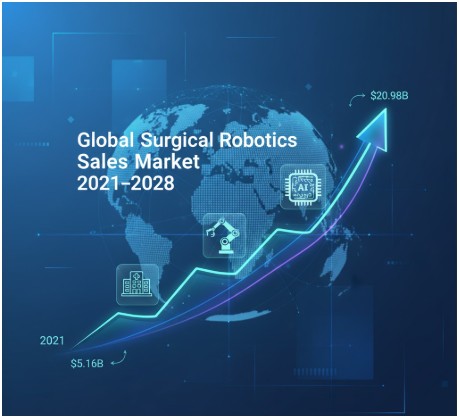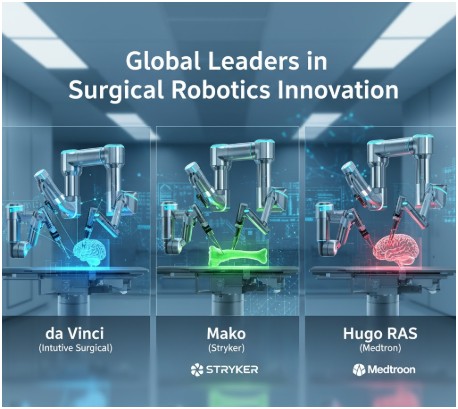I still remember the first time I watched a robot perform a surgical demonstration at a medical tech expo. The robotic arm moved with such grace—it stitched, cut, and cauterized with accuracy that felt almost human, maybe even better. That experience pulled me into researching the surgical robotics sales market, and honestly, I’ve been fascinated ever since. Watching machines and medicine collaborate to save lives feels like witnessing science fiction come true in real time.
What’s Driving the Growth of the Surgical Robotics Sales Market?

The first thing I noticed when exploring this market was its incredible pace. Back in 2021, the market stood at around $5.16 billion, but projections show it could reach a staggering $20.98 billion by 2028—that’s a CAGR of nearly 16.84%!
This growth isn’t random—it’s fueled by the global demand for minimally invasive surgeries. Patients now prefer smaller incisions, faster recovery, and less post-op pain. Surgeons benefit too; robotic systems give them precision and control that human hands alone can’t always match.
And then there’s technology. With the rise of AI integration, 3D imaging, and haptic feedback, these machines can “feel” resistance, adjust movements, and improve decision-making mid-procedure. It’s not just about cutting—it’s about confidence, consistency, and control.
Who’s Leading the Charge in the Surgical Robotics Sales Market?

If you’ve heard of the da Vinci system, you already know the king of this industry: Intuitive Surgical. With roughly 70–80% of the market share, they practically own the playing field. Their da Vinci robots handle everything from urology to gynecology to general surgery.
Intuitive’s strategy is smart—they don’t just sell the machine; they build loyalty through system-specific instruments and accessories. Hospitals that invest in da Vinci often keep returning for updates, training, and new parts.
Then comes Stryker, the orthopedic champion. Their Mako SmartRobotics system has revolutionized knee and hip replacements, and over 2 million Mako procedures have already been performed worldwide.
And let’s not forget Medtronic, the challenger with global ambition. After acquiring Mazor Robotics, Medtronic entered spine and neurosurgery segments with impressive force. Their Hugo RAS system, which got its CE mark in 2021, adds serious competition to Intuitive’s dominance.
How Are Smaller Players Shaping the Surgical Robotics Sales Market?

While giants lead the race, niche innovators keep things interesting. THINK Surgical zeroes in on orthopedic robotics, offering solutions for Total Knee Arthroplasty (TKA). They compete head-on with Stryker and Zimmer Biomet, aiming for precision and flexibility in joint surgeries.
Meanwhile, Restoration Robotics brought something completely different to the table—robotic hair restoration. After merging with Venus Concept, its technology became part of a larger aesthetic medical device ecosystem. Though not a major player in general or orthopedic applications, it proved that surgical robotics could reach unexpected corners of medicine.
What Challenges Does the Surgical Robotics Sales Market Face?
It’s not all smooth operating rooms and glowing dashboards. The biggest hurdle? Cost.
A single robotic surgery system can cost up to $2.5 million, and that’s before factoring in maintenance, software updates, and instrument replacements. Smaller hospitals struggle to justify the investment, especially when training surgeons adds more expense.
Then there’s the shortage of trained professionals. These systems demand not just surgical expertise but also digital literacy and technical adaptability. Many hospitals have the hardware but lack the skilled hands to use it fully.
And don’t get me started on regulatory complexity. Different countries have different approval processes, and keeping up can delay product launches and limit market entry.
Still, every challenge fuels innovation. Companies are now working on modular, affordable systems and enhanced training programs to bridge these gaps.
How Do These Systems Actually Make Money?
One of the most fascinating insights I discovered is that most profit doesn’t come from the initial sale—it comes from the recurring revenue of instruments and accessories.
Hospitals buy replacement tools for each procedure, which ensures a steady stream of sales. So even though installing a system is a huge one-time cost, the ongoing use of consumables and software keeps the financial wheel turning.
It’s like owning a luxury car—you pay once for the vehicle, but you’ll always need fuel, tires, and servicing. That’s how companies like Intuitive Surgical maintain dominance and continuous revenue growth.
How to Understand Market Position: Comparing the Big Names
| Company | Key Product | Market Focus | Strategy |
| Intuitive Surgical | da Vinci Surgical System | General, Urology, Gynecology | Large installed base, patent expansion, accessory sales |
| Stryker | Mako SmartRobotics | Orthopedics | Specialized in knee and hip replacements |
| Medtronic (Mazor Robotics) | Hugo RAS, Spine Systems | Neurosurgery, Urology | R&D in India, global diversification |
| THINK Surgical | TKA Systems | Orthopedic niche | Competes with Stryker & Zimmer |
| Restoration Robotics | ARTAS | Aesthetic procedures | Acquired by Venus Concept |
What’s Next for the Surgical Robotics Sales Market?
The next few years will be thrilling. I expect robotics to move beyond operating rooms and into remote surgeries, where a surgeon could operate from another continent using real-time robotics and 5G connectivity.
AI will continue shaping decision-making, reducing human error, and possibly predicting complications before they occur. Add machine learning algorithms that learn from thousands of prior surgeries, and you’ve got the perfect mix of precision and personalization.
As more hospitals see proven outcomes, adoption rates will rise. It’s no longer about replacing surgeons—it’s about empowering them.
FAQs About the Surgical Robotics Sales Market
Q1: Why are robotic surgeries becoming so popular?
People love them because they mean smaller cuts, less blood loss, and quicker recovery. Surgeons benefit from enhanced precision and control, especially in delicate procedures like prostate or heart surgery. It’s a win-win situation.
Q2: Which company leads the surgical robotics sales market?
Intuitive Surgical dominates with its da Vinci system, holding about 70–80% of the market. However, Stryker and Medtronic are rapidly growing competitors, especially in orthopedic and spine surgeries.
Q3: Are these robots replacing human surgeons?
Not at all. They assist, not replace. Robots can’t think or make ethical decisions. They follow surgeon input, offering enhanced steadiness and precision—kind of like a super-tool guided by a human expert.
Q4: How much does a surgical robot cost?
Depending on the model and features, systems can range from $1 million to $2.5 million, not counting annual maintenance and disposable instruments. The investment pays off through efficiency, better outcomes, and long-term savings.
Slicing Into the Future—My Final Take
Every time I see a robotic arm glide across an operating table, I’m reminded of how far medicine has come. The surgical robotics sales market doesn’t just represent money—it represents trust, progress, and the merging of human compassion with machine precision.
If I had to bet on the future of surgery, I’d put my chips on robotics. The mix of innovation and healing power makes it one of the most exciting frontiers in healthcare. My advice? Keep an eye on emerging players—they’re the ones who might just redefine what’s possible inside the operating room.







